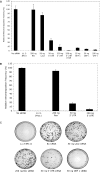A potential role for RNA interference in controlling the activity of the human LINE-1 retrotransposon
- PMID: 15701756
- PMCID: PMC549394
- DOI: 10.1093/nar/gki223
A potential role for RNA interference in controlling the activity of the human LINE-1 retrotransposon
Abstract
Long interspersed nuclear elements (LINE-1 or L1) comprise 17% of the human genome, although only 80-100 L1s are considered retrotransposition-competent (RC-L1). Despite their small number, RC-L1s are still potential hazards to genome integrity through insertional mutagenesis, unequal recombination and chromosome rearrangements. In this study, we provide several lines of evidence that the LINE-1 retrotransposon is susceptible to RNA interference (RNAi). First, double-stranded RNA (dsRNA) generated in vitro from an L1 template is converted into functional short interfering RNA (siRNA) by DICER, the RNase III enzyme that initiates RNAi in human cells. Second, pooled siRNA from in vitro cleavage of L1 dsRNA, as well as synthetic L1 siRNA, targeting the 5'-UTR leads to sequence-specific mRNA degradation of an L1 fusion transcript. Finally, both synthetic and pooled siRNA suppressed retrotransposition from a highly active RC-L1 clone in cell culture assay. Our report is the first to demonstrate that a human transposable element is subjected to RNAi.
Figures




References
-
- Lander E.S., Linton L.M., Birren B., Nusbaum C., Zody M.C., Baldwin J., Devon K., Dewar K., Doyle M., FitzHugh W., et al. Initial sequencing and analysis of the human genome. Nature. 2001;409:860–921. - PubMed
-
- Ostertag E.M., Kazazian H.H., Jr Biology of mammalian L1 retrotransposons. Annu. Rev. Genet. 2001;35:501–538. - PubMed
-
- Hohjoh H., Singer M.F. Ribonuclease and high salt sensitivity of the ribonucleoprotein complex formed by the human LINE-1 retrotransposon. J. Mol. Biol. 1997;271:7–12. - PubMed
Publication types
MeSH terms
Substances
Grants and funding
LinkOut - more resources
Full Text Sources
Other Literature Sources

